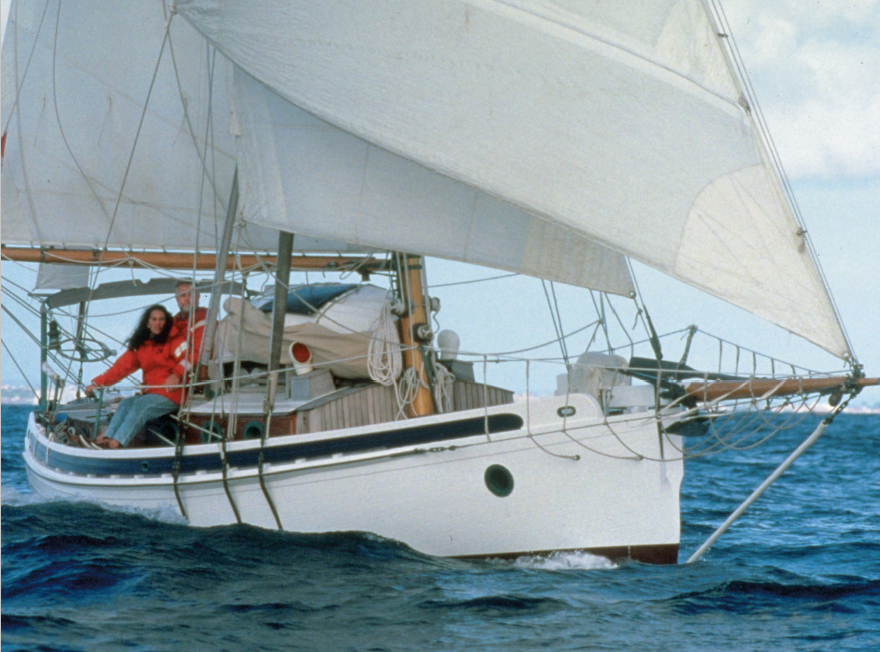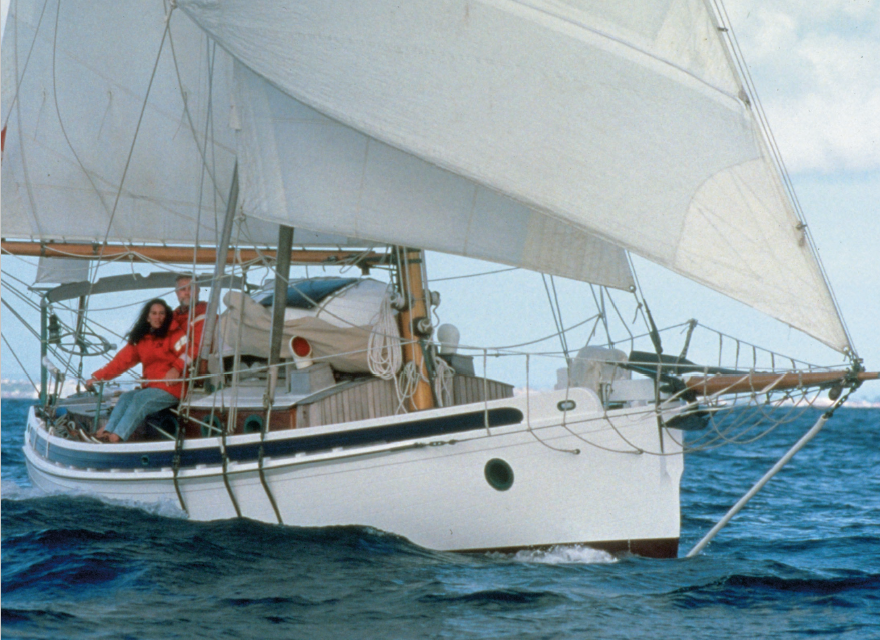
I guess we could sense trouble even before it started. The 35-foot sloop was making a downwind approach into the crowded mooring area, its engine running, a spray dodger in place so the helmsman had a hard time seeing the woman who stood on the foredeck armed with a boathook. The 10-knot breeze blew their shouted words down to us. “Head more that way,” she yelled. “Where’s the mooring?” he yelled. “Head more that way,” she yelled again, obviously unaware that the noise of the engine, the dodger, and the wind kept the helmsman from hearing her words.
We could see the helmsman’s plan, a quick round up into the wind with the tide to slow the boat down right next to the mooring pendant. But his partner on the foredeck didn’t seem to know. With her drowned yelling and the ensuing confusion, they missed the mooring pickup and had to try again twice. By that time a shouting match developed that embarrassed both of us into going below with our drinks.
An hour later I was in the club showers when the woman walked in. “I quit,” she said. “This is the last time I’ll get on that damn boat with him. He never tells me what’s going on; then he shouts at me until I get frazzled. When we go home he spends hours blaming me for making him look foolish on the boat.” She was embarrassed by their foul-ups too. “Why can Old Bailey sail a 64-foot, engineless yacht up to his mooring every time, no shouting, no hassles, almost like a precision dance team?” she asked.
Communication is key
I knew what she meant; I’d watched Mr. Bailey sail his 12-meter News Boy through the tightly packed moorings in Newport Beach. I knew some crews who could sail into the tightest situations and look cool and relaxed. The key to their success is careful communication, good planning, crew cooperation, and lots of practice.
The first link in any communications chain is making sure everyone on board is speaking the same language. This may sound corny, but if you call your small genoa a lapper one day and a genoa the next, you are bound to confuse the person who is handling the foredeck. It goes back to the old sailing days when every line, every sail and halyard had its own distinct name and its own distinct position on board all ships.
The next step is to call a huddle before each maneuver. Whoever is in charge should explain what he or she has in mind, which person should do each part of the job, and when each move should be made. Even after 30 years of sailing together, Larry and I still confer each time we get ready to get under way or come into a mooring, dock, or anchorage. This “war council” not only makes later communication more effective, it helps you make sure everyone is ready to go.
Two friends of ours were leaving for a month of cruising. They’d just carried the last-minute stores on board; then John set to work removing sail covers, clearing the deck, and untying the safety line to their mooring. Meanwhile Ellie was busy below rushing to put away stores in the bilge, in settee lockers, and behind bunk cushions. They were in a hurry to catch some friends who wanted to rendezvous in Catalina, so maybe that’s why John decided to set sail and cast off the mooring without calling a huddle. He didn’t even make sure Ellie heard his call of, “Everything ready? I’m getting under way.”
Just when John steered clear of the mooring buoy he realized he’d forgotten the jib sheets. He rushed down the companionway and tried to stop, but it was too late. His foot went past the open floor boards and into the bilge. And there he stood, up to his calves in seven dozen crushed eggs. Needless to say, that day’s voyaging got off on the wrong foot.

Lin and Larry Pardey have cruised together since Oct. 31, 1968, when they took their marriage vows and launched their boat. That first boat, Seraffyn, was a wooden homebuilt Lyle Hess-designed gaff cutter. The Pardeys voyaged 45,000 miles aboard Seraffyn before launching Taleisin in 1979. They continue to sail Taleisin, more than 51,000 miles later.
Planning counts
In tight situations such as sailing or powering out of a crowded marina, it pays to spell out each part of the planned maneuver, then have each crew person check the gear they’ll be handling. Are the jib sheets led correctly, is the boathook free of its holder, are the mooring lines ready to run freely? Don’t let anything rush this pre-maneuver check. The one time we didn’t follow this rule, I ended up with a broken leg … and that was after 11 years of voyaging together.
We were hurrying to catch the tide under the Second Narrows bridge so we would be in time for opening day maneuvers at our yacht club (West Vancouver Yacht Club). There were a lot of friends on the dock at the Royal Vancouver Yacht Club who’d come to see us off. Some were helping us put the sails on; three cast off our mooring lines.
Instead of having our normal conference and quick gear check, I hoisted the lapper, then went back to steer after we’d cleared the dock. Everything seemed fine until we tacked 200 yards from the club. Larry put all his strength into pulling the genoa sheet. Someone hadn’t tied a proper bowline. The sheet came loose from the sail, Larry fell back across the cockpit, landed against my leg, and I had a nice clean fracture of the fibula. We were both at fault for not taking the time to confer then check our gear.
If the maneuver you are planning is something new to you and your crew, or if there is something like a swiftly running tide or unusual wind shifts that could cause a foul-up, take a dry run. Sail or power past the place where you want to moor. Check the position of bollards or cleats, make sure there is sufficient room for your boat. Discuss anything that could interfere with you or your crew doing a neat job of landing. Then sail back to clear water for that final check on mooring gear. Larry would have avoided an ugly scrape on Seraffyn’s topsides if he’d taken a dry run before sailing up to the seawall at Brindisi, Italy, when he was out alone one day. He would have spotted the pipe protruding from the seawall and saved himself a nasty bruise, too.

Skipper’s in charge
You’ll notice that all of these suggestions seem to be aimed at a skipper. This may not seem democratic, but on a sailing boat democracy doesn’t work. We’ve seen the chaos that happens when four or five experienced skippers end up on the same boat. Everyone wants to issue orders; no one really wants to take them. This leads to mistakes and temper tantrums. So choose a skipper for each day or each passage if somebody hasn’t assumed that position already. Larry and I take turns being in charge. We change off almost every time we enter a new port. That divides the responsibility up and gives me a chance to learn more about making sailing decisions.
But just because you don’t happen to be a skipper for the day doesn’t mean you have no responsibilities for the safety or smart handling of your boat. During the pre-maneuver huddles, mention any facts that may be helpful. Point out the wind wavelets being caused by a gust coming into the anchorage, mention the unsecured halyard tail or partially unpacked stores below deck. Even the most experienced skipper has a hard time noting everything on deck, below, and ahead.
Once you start any maneuver, every person on board must repeat every order and make sure the skipper knows each job is complete. Sure it seems formal to call back “Anchor’s coming up” or “Staysail’s going up” after the orders are called to you. But this is the only way each person on board knows what’s going on. It’s very easy for the person on a windy foredeck to miss hearing a call of, “Is the mooring clear?” If the engine is running, this is even more important. Remember the engine is louder in the cockpit than it is on the foredeck.
Don’t be afraid to yell to make sure you are heard; even better yet, arrange for hand signals when you must maneuver with the engine. But with either hand signals or shouted orders, repeat each order. It’s far better to repeat orders than to get into a shouting match when a maneuver deteriorates into a mishap because someone aft didn’t hear you.
This repeating of orders is one of the biggest weaknesses Larry and I have when we sail together. I hate to yell. He sometimes doesn’t hear me and so assumes everything is done. Then I end up rushing or tangled in a mooring line I didn’t have time to flake down completely. The British Navy felt this repeating of each command and order was so important that men who failed to comply were put in the brig for three days. A cruising boat is not a naval ship, but crew cooperation makes life in close quarters and tight situations far safer and more comfortable.
Check details
Half the fun of sailing is talking over the near misses or neat maneuvers afterward. This is an important part of learning to sail as a team. Once the laughs are over, a careful analysis of each crew’s part in the “almost” situation will help the next time you are out sailing together. At first I put all of the blame for one of our most embarrassing sailing stunts on Larry’s shoulders. We were flying down the Solent on a sunny Sunday afternoon in May, spinnaker set, four knots of tide under us, 15 knots of breeze shoving us at a combined speed of close to 10 knots. Just ahead lay the river Cowes with a sand bank stretched out into our path. We could already see binoculars flashing from the verandah of the Royal Yacht Squadron headquarters. “Let’s make this look real smart,” Larry suggested. “You take the helm; I’ll lead the spinnaker halyard back to you. Then when we’re right abeam of the clubhouse we’ll drop the chute behind the mainsail, jibe, and round up into the river. OK?”
“Sounds great,” I answered, as I led the spinnaker guy so it was clear and ready to run. I took the halyard without even glancing down. Larry went forward. The clubhouse was right on our beam maybe 400 yards away when he called, “Ease the halyard.” I did. “Ease the halyard,” Larry called even louder. I did. “Ease the G– d— halyard!” he yelled.
I looked aloft to see what was wrong as we rushed ever closer to that sand bank. “Larry,” I said, “the mainsail is coming down.” Well, we did a Chinese jibe, put our tails between our legs and didn’t moor near the Royal Yacht Squadron that day. But later when we were having our post mortem, I realized I was as much at fault as Larry. Each halyard on Seraffyn was slightly different. The spinnaker halyard was thinner than the main halyard. If I’d been doing my part, I’d have looked at the line Larry handed me and noticed the difference. Careful smart boat handling only happens when all members on board take responsibility for more than just their own jobs.
Some yelling goes
One lesson I have learned the hard way through 22 years of sailing with various crews on deliveries and race boats is that few women are able to unemotionally accept the occasional yelling that is part and parcel of any physical sport. Unless they have been involved in team sports during their school days, they may never have been yelled at by a person who is reacting to the emotional pressures of the situation and the tension of the moment and not really yelling at them. When I took an introductory course in karate, I was surprised to find that we were instructed to shout as one of the ways to increase the power of each action we made. The shout was supposed to release tension and direct power. The men in my beginner’s class had no trouble at all in letting out full-powered keii’s. The women had to have separate practice sessions, shouting at each other to overcome our ingrained reluctance to making aggressive sounds. Eventually I came to rather enjoy the chance to make big noises.
The next step in learning to live with this shouting problem was to depersonalize it. I’d listened to men on race boats, on football teams, and in beachfront volleyball games using abusive and rude words toward each other, then 10 minutes later laughing together over a mug of beer. I’d even heard this tension-caused yelling from all-women sailboat racing teams. Yet as a wife of my sailing partner, I occasionally came close to tears or rebellion when Larry used his fore- topsail voice during a race and yelled, “put your G– d—- back into it, haul on that f—ing downhaul!”
Fortunately Larry would usually notice my stiffening back and angry face then defuse the potential crisis by calling, “Don’t take it personally, just keep the boat moving!”
Eventually I came to accept this and actually laugh it off. “Calm down, you macho turkey,” I yelled back one day. Larry grinned back at me. The whole crew began to laugh, and I was on the way to living more comfortably with this least pleasant aspect of sailing.
No matter how much you practice together … no matter how meticulous you are about planning maneuvers and relaying orders, just enough foul-ups will happen as you sail together to make two last things very important. Tension- free shipboard life can only happen when you keep a sense of proportion and refine your sense of humor.
When the tide back-eddies and the captain of the day nips a quarter of an inch off the end of the freshly varnished bowsprit, when your crew jumps for the dock, slips on a fish head and misses the cleat so you end up with a 12-inch scratch on the topsides, remember this is a sport and a boat can always be repaired with a bit of paint, a bit of putty. The only catastrophes worth more than an evening’s rehash are human injuries or lost tempers that lead to marriage partners refusing to sail together. If you work to make sailing into a sport … if you learn to plan and communicate then remember your sense of humor before it is too late, you may find the same rules can extend into other areas of your lives.
Excerpted from Lin and Larry’s book, The Self-Sufficient Sailor. The Pardeys’ books are available from Paradise Cay Publications, 800-736-4509.





